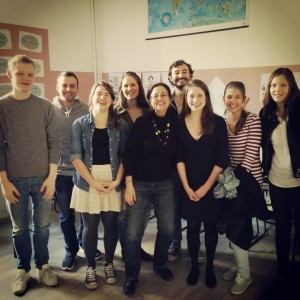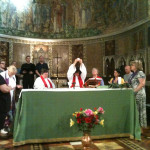Piano, piano
For the past four weeks I have been in Italian immersion classes, while living with an Italian host family in Rome. The school, DiLit, prioritizes listening and speaking practice over grammatical exercises, complimented with cultural seminars and excursions throughout the city. Empowering students to open their mouths and build brain connections prior to writing (a challenging personality gymnastic for introverts!) helped students to build sentences organically and musically. January and February are certainly the off-season in Rome. With rain each day, my classes were small, with mainly “gap-year” students from throughout Europe, Italiophiles who spend one week vacationing in Rome, priests, and even a future Vatican Swiss Guard.
The phrase “piano, piano,” is taught throughout the school to emphasize the process of learning, the phases, level by level, step by step. This will sound familiar to many in the women’s ordination movement; of course, too frequently this processing is heard as “wait your turn” or “give Pope Francis time.” But, I really like the motion of this phrase. When learning a language, the brain is doing so many silent steps, and progress can seem aloof. While watching a movie for instance, one can catch words and construct a sketch of a theme, but there are gaps in the dialogue. Nevertheless, synapses are sparking, and things are happening in those spaces. Like working out an idea or problem in your head, change can be seemingly very silent.
After taking a month away from women’s ordination activism and living in Rome mostly as an observer, a listener, I am even more hopeful of our goals.
Typically in our classes we introduce ourselves with our name, nationality, a bit about our work or studies, and why we’re learning Italian. At first I would vaguely say I work for a Catholic organization for women in the Church. But, piano, piano, I would share our mission. My favorite reactions were from a young priest, and from my teacher.
Mi chiamo Katherine. Sono Americana, e lavoro per l’ordinazione delle donne nella Chiesa cattolica… Donne Sacerdote nella Chiesa Cattolica.
The priest’s eyes bulged, and then he lowered his head and smiled and with a full body nod said, “I agree with you. It is a good thing.” (in English)
My teacher shared her own story about a high school retreat (or the Tuscan equivalent), with two elegant sisters from Japan and Belgium, and one priest, who throughout the week insisted on giving everyone communion, something the sisters usually distributed themselves. The sisters stayed poised and quietly resentful for the first few days, but then began a discussion, and then a heated exchange about the ordination of
women to the tune of: “E’ IMPOSSIBILE!” “NON IMPOSSIBILE!” (We’ve all had this deep discussion ourselves, right?). The sisters eventually told the priest: “Just wait, you’ll see.” These sisters went on to work at the Vatican, my teacher said (for better or worse, I suppose!). For someone who has traveled to Rome several times, mostly to be excluded, barred, and detained, these local anecdotes are little victories. One class even watched a documentary video on Italian woman priest Maria Vittoria Longhitano. On the last day of class I also read the Univison poll, with the statistic that 59% of Italians support the ordination of women. Very similar to the New York Times’ statistic for the US that came out last year. This is good news.
So now even with a little Italian in my pocket, I am still very much a listener in this city, just with more and more to say. I still have to focus to understand, taking in as many context clues as I can.
But something is in motion. Piano, piano.



